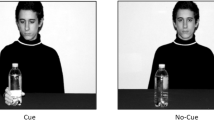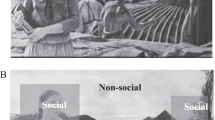Abstract
This study investigated joint attention and visual perspective taking abilities in young children. Twenty children with autism spectrum disorder in the age range of 3–7 years, and 20 age-matched control children participated in the study. Joint attention was assessed by a spontaneous gaze monitoring task, and two tasks measuring eye contact in ambiguous situations. Visual perspective taking was measured using a Level 1 task [(Flavell, J. H., 1978). Nebraska symposium on motivation, Vol. 25, University of Nebraska Press, Lincoln]. The children with autism spectrum disorder were not only found to be impaired in their joint attention abilities, but they also showed problems on the visual perspective taking task. These results suggest that the basic dyadic person-object processes may develop in a slower and perhaps qualitatively different way in children with autism spectrum disorder.
Similar content being viewed by others
References
American Psychiatric Association. (1994). Diagnostic and statistical manual of mental disorders, 4th edn., Author, Washington, DC.
Bailey, A., Phillips, W., and Rutter, M. (1996). Autism: Towards an integration of clinical, genetic, neuropsychological and neurobiological perspectives. J. Child Psychol. Psychiatry 37: 89–126.
Bakeman, R., and Adamson, L. B. (1984). Coordinating attention to people and objects in mother–infant and peer–infant interaction. Child Dev. 55: 1278–1289.
Baldwin, D. A. (1993). Early referential understanding: Infant’s ability to recognize referential acts for what they are. Dev. Psychol. 29: 832–843.
Baron-Cohen, S. (1988). Social and pragmatic deficits in autism: Cognitive or affective? J. Autism Dev. Disord. 3: 379–402.
Baron-Cohen, S. (1989). Perceptual role taking and protodeclarative pointing in autism. Br. J. Dev. Psychol. 7: 113–127.
Baron-Cohen, S. (1994). How to build a baby that can read minds: Cognitive mechanisms in mindreading. Cahiers Psychol. Cogn. 13: 513–552.
Baron-Cohen, S. (1995). The Eye Direction Detector (EDD) and the Shared Attention Mechanism (SAM): Two cases for evolutionary psychology. In Moore, C., and Dunham, P. J. (eds.), Joint Attention: Its origins and role in development, Erlbaum, Hillsdale, NJ, pp. 41–60.
Baron-Cohen, S., Leslie, A. M., and Frith, U. (1985). Does the autistic child have a “theory of mind”? Cognition 21: 37–46.
Baron-Cohen, S., Leslie, A. M., and Frith, U. (1986). Mechanical, behavioral and intentional understanding of picture stories in autistic children. Br. J. Dev. Psychol. 4: 113–125.
Baron-Cohen, S., Ring, H. A., Bullmore, E. T., Wheelwright, S., Ashwin, C., and Williams, S. C. R. (2000). The amygdala theory of autism. Neurosci. Biobehav. Rev. 24: 355–364.
Bushwick, N. L. (2001). Social learning and the etiology of autism. New Ideas Psychol. 19: 49–75.
Butterworth, G. (1995). Origins of mind in perception and action. In Moore, C., and Dunham, P. J. (eds.), Joint Attention: Its Origins and Role in Development, Erlbaum, Hillsdale, NJ, pp. 29–40.
Butterworth, G., and Cochran, E. (1980). Towards a mechanism of joint visual attention in human infancy. Int. J. Behav. Dev. 3: 253–272.
Butterworth, G., and Jarrett, N. (1991). What minds have in common is space: Spatial mechanisms serving joint visual attention in infancy. Br. J. Dev. Psychol. 9: 55–72.
Charman, T. (1998). Specifying the nature and course of the joint attention impairment in autism in the preschool years. Autism 2: 61–79.
Charman, T., Baron-Cohen, S., Swettenham, J., Baird, G., Cox, A., and Drew, A. (2000). Testing joint attention, imitation, and play as infancy precursors to language and theory of mind. Cogn. Dev. 15: 481–498.
Corkum, V., and Moore, C. (1995). Development of joint visual attention in infants. In Moore, C., and Dunham, P. J. (eds.), Joint Attention: Its Origins and Role in Development, Erlbaum, Hillsdale, NJ, pp. 61–84.
Corkum, V., and Moore, C. (1998). The origins of joint visual attention in infants. Dev. Psychol. 34: 28–38.
Dawson, G., and Fernald, M. (1987). Perspective-taking ability and its relationship to the social behavior of autistic children. J. Autism Dev. Disord. 17: 487–498.
DiLavore, P., and Lord, C. (1995). Do you see what I see? Requesting and joint attention in young autistic children. Poster presentation at the Biennal Conference of the Society for Research in Child Development, Indianapolis, IN.
Doherty, M. J., and Anderson, J. R. (1999). A new look at gaze: Preschool children’s understanding of eye-direction. Cogn. Dev. 14: 549–571.
Flavell, J. H. (1974). The development of inferences about others. In Mischell, T. (ed.), Understanding Other Persons, Blackwell, Oxford.
Flavell, J. H. (1978). The development of knowledge about visual perception. In Keasey, C. B. (ed.), Nebraska Symposium on Motivation, Vol. 25, University of Nebraska Press, Lincoln.
Flavell, J. H., Flavell, E. R., Green, F. L., and Wilcox, S. A. (1980). Young children’s knowledge about visual perception: Effect of observer’s distance from target on perceptual clarity of target. Dev. Psychol. 16: 10–12.
Frith, U. (2000). Cognitive explanations of autism. In Lee, K. (ed.), Childhood Cognitive Development: The Essential Readings, Blackwell, Oxford, UK, pp. 324–337.
Gomez, J. C., Sarria, E., and Tamarit, J. (1993). The comparative study of early communication and theories of mind: Ontogeny, phylogeny and pathology. In Baron-Cohen, S., Tager-Flusberg, H., and Cohen, D. J. (eds.), Understanding Other Minds: Perspectives From Autism, Oxford University Press, Oxford, pp. 397–426.
Hobson, R. P. (1984). Early childhood autism and the question of egocentrism. J. Autism Dev. Disord. 14: 85–104.
Kanner, L. (1943). Autistic disturbances of affective contact. Nerv. Child 2: 217–250.
Kasari, C., Sigman, M., Mundy, P., and Yirmiya, N. (1990). Affective sharing in the context of joint attention interactions of normal, autistic, and mentally retarded children. J. Autism Dev. Disord. 20: 87–100.
Klin, A., Volkmar, F. R., and Sparrow, S. S. (1992). Autistic social dysfunction: Some limitations of the theory of mind hypothesis. J. Child Psychol. Psychiatry 33: 861–876.
Leekam, S., Baron-Cohen, S., Perrett, D., Milders, M., and Brown, S. (1997). Eye-direction detection: A dissociation between geometric and joint attention skills in autism. Br. J. Dev. Psychol. 15: 77–95.
Leekam, S. R., Hunnisett, E., and Moore, C. (1998). Targets and cues: Gaze-following in children with autism. J. Child Psychol. Psychiatry 39: 951–962.
Leekam, S. R., López, B., and Moore, C. (2000). Attention and joint attention in preschool children with autism. Dev. Psychol. 36: 261–273.
Leslie, A. M. (1991). The theory of mind impairment in autism: Evidence for a modular mechanism of development? In Whiten, A. (ed.), Natural Theories of Mind: Evolution, Development and Simulation of Everyday Mindreading, Blackwell, Oxford, UK, pp. 63–78.
Lord, C. (1993). The complexity of social behavior in autism. In Baron-Cohen, S., Tager-Flusberg, H., and Cohen, D. J. (eds.), Understanding Other Minds: Perspectives From Autism, Oxford University Press, Oxford, pp. 292–316.
McCarthy, D. A. (1972). Manual for the McCarthy Scales of Children’s Abilities, The Psychological Corporation, San Antonio, TX.
Moore, C., and Corkum, V. (1994). Social understanding at the end of the first year of life. Dev. Rev. 14: 349–372.
Morisette, P., Ricard, M., and Decarie, T. (1995). Joint visual attention and pointing in infancy: A longitudinal study of comprehension. Br. J. Dev. Psychol. 13: 163–175.
Mundy, P. (1995). Joint attention and social-emotional approach behavior in children with autism. Dev. Psychopathol. 7: 63–82.
Mundy, P., Sigman, M., and Kasari, C. (1993). The theory of mind and joint-attention deficits in autism. In Baron-Cohen, S., Tager-Flusberg, H., and Cohen, D. J. (eds.), Understanding Other Minds: Perspectives From Autism, Oxford University Press, Oxford, pp. 181–203.
Mundy, P., Sigman, M., and Kasari, C. (1994). Joint attention, developmental level, and symptom presentation in autism. Dev. Psychopathol. 6: 389–401.
Osterling, J., and Dawson, G. (1994). Early recognition of children with autism: A study of first birthday home videotapes. J. Autism Dev. Disord. 24: 247–257.
Ozonoff, S., Strayer, D. L., McMahon, W. M., and Filloux, F. (1994). Executive function abilities in autism and Tourette’s syndrome: An information processing approach. J. Child Psychol. Psychiatry 35: 1015–1032.
Phillips, W., Baron-Cohen, S., and Rutter, M. (1992). The role of eye contact in goal detection: Evidence from normal infants and children with autism or mental handicap. Dev. Psychopathol. 4: 375–383.
Premack, D. (1990). The infant’s theory of self-propelled objects. Cognition 36: 1–16.
Premack, D. (1991). The infant’s theory of self-propelled objects. In Frye, D., and Moore, C. (eds.), Children’s Theories of Mind, Erlbaum, Hillsdale, NJ, pp. 39–48.
Premack, D., and Woodruff, G. (1978). Does the chimpanzee have a “theory of mind”? Behav. Brain Sci. 4: 515–526.
Reed, T. (2002). Visual perspective taking as a measure of working memory in participants with autism. J. Dev. Phys. Disabil. 14: 63–76.
Reynell, J., and Huntley, M. (1987). Reynell Developmental Language Scales, 2nd Rev., NFER-Nelson, Windsor, UK.
Roeyers, H., Van Oost, P., and Bothuyne, S. (1998). Immediate imitation and joint attention in young children with autism. Dev. Psychopathol. 10: 441–450.
Rogers, S. J., and Pennington, B. F. (1991). A theoretical approach to the deficits in infantile autism. Dev. Psychopathol. 3: 137–162.
Scaife, R., and Bruner, J. S. (1975). The capacity for joint visual attention in the infant. Nature 253: 265–266.
Tan, J., and Harris, P. L. (1991). Autistic children understand seeing and wanting. Dev. Psychopathol. 3: 163–174.
Tomasello, M. (1995). Joint attention as social cognition. In Moore, C., and Dunham, P. J. (eds.), Joint Attention: Its Origins and Role in Development, Erlbaum, Hillsdale, NJ, pp. 103–129.
Volkmar, F. R. (1987). Social development. In Cohen, D. J., Donnellan, A. M., and Paul, R. (eds.), Handbook of Autism and Pervasive Developmental Disorders, Wiley, New York, pp. 41–61.
Wainwright, J. A., and Bryson, S. E. (1996). Visual-spatial orienting in autism. J. Autism Dev. Disord. 26: 423–438.
Wechsler, D. (1966). Wechsler Preschool and Primary Scale of Intelligence, The Psychological Corporation, New York.
Wechsler, D. (1989). Wechsler Preschool and Primary Scale of Intelligence, Rev. edn., The Psychological Corporation, New York.
Wing, L. (1980). Early Childhood Autism, Pergamon, Oxford.
Yirmiya, N., Sigman, M., and Zacks, D. (1994). Perceptual perspective-taking and seriation abilities in high-functioning children with autism. Dev. Psychopathol. 6: 263–272.
Author information
Authors and Affiliations
Corresponding author
Rights and permissions
About this article
Cite this article
Warreyn, P., Roeyers, H., Oelbrandt, T. et al. What Are You Looking at? Joint Attention and Visual Perspective Taking in Young Children With Autism Spectrum Disorder. J Dev Phys Disabil 17, 55–73 (2005). https://doi.org/10.1007/s10882-005-2201-1
Issue Date:
DOI: https://doi.org/10.1007/s10882-005-2201-1




